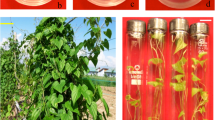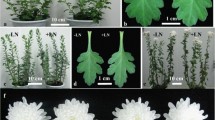Abstract
Shallot (Allium cepa var. aggregatum), a small bulb onion, is widely grown in the world. We previously reported a droplet-vitrification for cryopreservation of in vitro-grown shoot tips of shallot genotype ‘10603’. The present study further evaluated rooting, vegetative growth, bulb production and contents of biochemical compounds, as well as genetic stability in cryo-derived plants. The results showed no significant differences in rooting, vegetative growth, bulb production and contents of soluble sugars and flavonols between the cryo- and in vitro-derived plants. Analyses of ISSR and AFLP markers did not detect any polymorphic bands in the cryo-derived plants. These results indicate rooting and vegetative growth ability, biochemical compounds and genetic stability were maintained in cryo-derived plants. The present study provides experimental evidences that support the use of cryopreservation method for long-term preservation of genetic resources of shallots and other Allium species.
Key message
Rooting, vegetative growth, bulb production, genetic stability and biochemical compounds were maintained in cryopreserved plants of shallot. Our results support use of cryopreservation for long-term preservation of shallot germplasm.



Similar content being viewed by others
Abbreviations
- AFLP:
-
Amplified fragment length polymorphism
- 6-BA:
-
6-Benzylaminopurine
- ISSR:
-
Inter-simple sequence repeat
- LN:
-
Liquid nitrogen
- LNV:
-
Liquid nitrogen vapor
- MS:
-
Murashige and Skoog (1962)
- NAA:
-
1-Naphthylacetic acid
- SCM:
-
Stock culture medium
References
Agrawal A, Swennen R, Panis B (2004) A comparison of four methods for cryopreservation of meristems in banana (Musa spp.). Cryo-Letters 25:101–110
Ahuja S, Mandal BB, Dixit S, Srivastava PS (2002) Molecular, phenotypic and biosynthetic stability in Dioscorea floribunda plants derived from cryopreserved shoot tips. Plant Sci 163:971–977
Bednarek PT, Orłowska R (2020) Plant tissue culture environment as a switch-key of (epi)genetic changes. Plant Cell Tissue Organ Cult 140:245–257
Benson EE (2008) Cryopreservation of phytodiversity: a critical appraisal of theory & practice. Crit Rev Plant Sci 27:141–219
Bi W-L, Pan C, Liu J, Wang Q-C (2016) Greenhouse performance, genetic stability and biochemical compounds in Chrysanthemum morifolium ‘Hangju’plants regenerated from cryopreserved shoot tips. Acta Physiol Plant 38:268. https://doi.org/10.1007/s11738-016-2288-2
Bi W-L, Hao X-Y, Cui Z-H, Volk GM, Wang Q-C (2018) Droplet-vitrification cryopreservation of in vitro-grown shoot tips of grapevine (Vitis spp.). In Vitro Cell Dev Biol Plant 54:590–599
Carmona-Martín E, Regalado JJ, PeránQuesada R (2018) Cryopreservation of rhizome buds of Asparagus officinalis L. (cv. Morado de Huétor) and evaluation of their genetic stability. Plant Cell Tissue Organ Cult 133:395–403
Ciringer T, Martín C, Šajna N, Kaligarič M, Ambrožič-Dolinšek J (2018) Cryopreservation of an endangered Hladnikia pastinacifolia Rchb. by shoot tip encapsulation-dehydration and encapsulation-vitrification. In Vitro Cell Dev Biol Plant 54:565–575
Ellis D, Skogerboe D, Andre C, Hellier B, Volk GM (2006) Implementation techniques in the national plant germplasm system. Cryo-Letters 27:99–106
Ferioli F, D’Antuono LF (2016) Evaluation of phenolics and cysteine sulfoxides in local onion and shallot germplasm from Italy and Ukraine. Genet Resour Crop Evol 63:601–614
Fritsch R, Friesen N (2002) Evolution, domestication and taxonomy. In: Rabinowitch HD, Currah L (eds) Allium crop science: recent advances. CABI Publishing, New York, pp 5–30
Harding K, Staines H (2001) Biometric analysis of phenotypic characters of potato shoot-tips recovered from tissue culture, dimethyl sulphoxide treatment and cryopreservation. Cryo-Letters 22:255–262
Harding K (2004) Genetic integrity of cryopreserved plant cells: a review. Cryo-Letters 25:3–22
Kaity A, Ashmore SE, Drew RA (2009) Field performance evaluation and genetic integrity assessment of cryopreserved papaya clones. Plant Cell Rep 28:1421–1430
Keller ERJ (2002) cryopreservation of Allium sativum L. (Garlic). In: Towill LE, Bajaj YPS (eds) Biotechnology in Agriculture and Forestry 50, Cryopresrvation of Plant germplasm II. Springer, Berlin, pp 37–47
Keller ERJ (2005) Improvement of cryopreservation results in garlic using low temperature preculture and high-quality in vitro plantlets. Cryo-Letters 26:357–366
Keller ERJ, Senula A, Christine Z (2011) Alliaceae in cryopreservation, achievements and constraints. Acta Hortic 908:495–508
Kim H-H, Lee J-K, Yoon J-W, Ji J-J, Nam S-S, Hwang H-S, Cho E-G, Engelmann F (2006) Cryopreservation of garlic bulbil primordia by the droplet-vitrification procedure. Cryo-Letters 27:143–153
Kim HH, Lee JK, Hwang HS, Engelmann F (2007) Cryopreservation of garlic germplasm collections using the droplet-vitrification technique. Cryo-Letters 28:471–482
Kulus D, Rewers M, Serocka M, Mikuła A (2019) Cryopreservation by encapsulation-dehydration affects the vegetative growth of chrysanthemum but does not disturb its chimeric structure. Plant Cell Tissue Organ Cult 138:153–166
Leelarungrayub N, Rattanapanone V, Chanarat N, Gebicki JM (2006) Quantitative evaluation of the antioxidant properties of garlic and shallot preparations. Nutrition 22:266–274
Li B-Q, Feng C-H, Wang M-R, Hu L-Y, Volk GM, Wang Q-C (2015) Recovery patterns, histological observations and genetic integrity in Malus shoot tips cryopreserved using droplet-vitrification and encapsulation-dehydration procedures. J Biotechnol 214:182–191
Li J-W, Chen H-Y, Li X-Y, Zhang Z-B, Blystad D-R, Wang Q-C (2017) Cryopreservation and evaluations of vegetative growth, microtuber production and genetic stability in regenerants of purple-fleshed potato. Plant Cell Tissue Organ Cult 128:641–653
Li J-W, Ozudogru E-A, Li J, Wang M-R, Bi W-L, Lambardi M, Wang Q-C (2018) Cryobiotechnology of forest trees: recent advances and future prospects. Biodivers Conserv 27:795–814
Liu X-X, Wen Y-B, Cheng Z-H, Mou S-W (2017) Establishment of a garlic cryopreservation protocol for shoot apices from adventitious buds in vitro. Sci Hortic 226:10–18
Martín C, Kremer C, González I, González-Benito ME (2015) Influence of the cryopreservation technique, recovery medium and genotype on genetic stability of mint cryopreserved shoot tips. Plant Cell Tissue Organ Cult 122:185–195
Murashige T, Skoog F (1962) A revised medium for rapid growth and bioassays with tobacco tissue cultures. Physiol Plant 15:473–497
Rabinowitch HD, Kamenetsky R (2002) Shallot (Allium cepa, Aggregatum Group). In: Rabinowitch HD, Currah L (eds) Allium crop science: recent advances. CABI Publishing, New York, pp 409–430
Sakai K, Hirai D, Niino T (2008) Development of PVS-based vitrification and encapsulation–vitrification protocols. In: Barbara R (ed) Plant cryopreservation: a practical guide. Springer, New York, pp 33–57
Salama A, Popova E, Jones MP, Shukla MR, Fisk NS, Saxena PK (2018) Cryopreservation of the critically endangered golden paintbrush (Castilleja levisecta Greenm.): from nature to cryobank to nature. In Vitro Cell Dev Biol Plant 54:69–78
Sittisart P, Yossan S, Prasertsan P (2017) Antifungal property of chili, shallot and garlic extracts against pathogenic fungi, Phomopsis spp., isolated from infected leaves of para rubber (Hevea brasiliensis Muell. Arg.). Agric Nat Resour 51:485–491
Slimestad R, Fossen T, Vågen I-M (2007) Onions: a source of unique dietary flavonoids. J Agric Food Chem 55:10067–10080
Vågen IM, Slimestad R (2008) Amount of characteristic compounds in 15 cultivars of onion (Allium cepa L.) in controlled field trials. J Sci Food Agric 88:404–411
Wang B, Li J-W, Zhang Z-B, Wang R-R, Ma Y-L, Blystad D-R, Keller EJ, Wang Q-C (2014a) Three vitrification-based cryopreservation procedures cause different cryo-injuries to potato shoot tips while all maintain genetic integrity in regenerants. J Biotechnol 184:47–55
Wang B, Wang RR, Cui ZH, Li JW, Bi WL, Li BQ, Ozudogru EA, Volk GM, Wang QC (2014b) Potential applications of cryobiotechnology to plant genetic transformation and pathogen eradication. Biotechnol Adv 32:583–595
Wang L-Y, Li Y-D, Sun H-Y, Liu H-G, Tang X-D, Wang Q-C, Zhang Z-D (2017) An efficient droplet-vitrification cryopreservation for valuable blueberry germplasm. Sci Hortic 219:60–69
Wang M-R, Chen L, da Silva JAT, Volk GM, Wang Q-C (2018) Cryobiotechnology of apple (Malus spp.): development, progress and future prospects. Plant Cell Rep 37:689–709
Wang M-R, Zhang Z, Haugslien S, Sivertsen A, Rasmussen M, Wang Q-C, Blystad D-R (2019) Cryopreservation of shallot (Allium cepa var. aggregatum) shoot tips by droplet-vitrification. Acta Hortic 1234:241–248
Wang M-R, Zhang Z, Zámečník J, Bilavčík A, Blystad D-R, Haugslien S, Wang Q-C (2020) Droplet-vitrification for shoot tip cryopreservation of shallot (Allium cepa var. aggregatum): effects of PVS3 and PVS2 on shoot regrowth. Plant Cell Tissue Organ Cult 140:185–195
Yang J, Meyers KJ, van der Heide J, Liu RH (2004) Varietal differences in phenolic content and antioxidant and antiproliferative activities of onions. J Agric Food Chem 52:6787–6793
Zhang Z, Skjeseth G, Elameen A, Haugslien S, Sivertsen A, Clarke J, Wang Q-C, Blystad D-R (2015) Field performance evaluation and genetic integrity assessment in Argyranthemum ‘Yellow Empire’ plants recovered from cryopreserved shoot tips. In Vitro Cell Dev Biol Plant 51:505–513
Acknowledgements
We acknowledge financial supports from the Research Council of Norway (Project No. 255032/E50), NIBIO, Sagaplant, Gartnerhallen, Gartnerforbundet, and Landbruksdirektoratet/the Norwegian Genetic Resource Centre (Project No. 18/4272).
Author information
Authors and Affiliations
Contributions
MRW: performance of experiments of cryopreservation, rooting and vegetative growth, collection and analysis of data, and preparation of manuscript; ZZ: performance of experiments of genetic stability and biochemical compounds, collection and analysis of data and preparation of manuscript; RS: analysis of biochemical compounds; AE: performance of assessments of genetic stability, valuable discussion and revision of manuscript; DRB: chief scientist of the project, valuable discussion and providing financial supports; SH: maintenance of in vitro cultures, and assistance to experiments of cryopreservation and evaluations of in vitro rooting and vegetatitive growth; GS: maintenance of greenhouse-grown plants and evaluations of vegetative growth in greenhouse-grown plants; QCW: experimental design, analysis of data, and revision and editing of manuscript.
Corresponding authors
Additional information
Communicated by M. Angeles Revilla.
Publisher's Note
Springer Nature remains neutral with regard to jurisdictional claims in published maps and institutional affiliations.
Rights and permissions
About this article
Cite this article
Wang, MR., Hamborg, Z., Slimestad, R. et al. Assessments of rooting, vegetative growth, bulb production, genetic integrity and biochemical compounds in cryopreserved plants of shallot. Plant Cell Tiss Organ Cult 144, 123–131 (2021). https://doi.org/10.1007/s11240-020-01820-7
Received:
Accepted:
Published:
Issue Date:
DOI: https://doi.org/10.1007/s11240-020-01820-7




